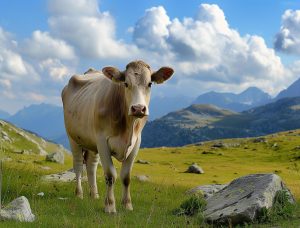Animal Healthcare
Calcium Homeostasis in Ruminants: Mechanisms and Challenges

Calcium plays a critical role in a wide array of physiological functions in ruminants, including muscle contraction, nerve transmission, enzyme activity, and milk production. As such, the regulation of calcium levels—known as calcium homeostasis—is vital for animal health, especially during periods of high demand such as late gestation and early lactation.
Maintaining calcium homeostasis in ruminants, particularly in dairy cattle, is complex and tightly regulated by hormonal and nutritional mechanisms. Failure to maintain adequate calcium levels can lead to clinical and subclinical hypocalcemia, posing serious risks to animal health and productivity.
Mechanisms of Calcium Homeostasis
Calcium homeostasis in ruminants involves a finely tuned balance between dietary intake, bone mobilization, and renal excretion, regulated primarily by three key hormones: parathyroid hormone (PTH), calcitriol (active vitamin D3), and calcitonin.
- Parathyroid Hormone (PTH)
When blood calcium levels drop, PTH is secreted to stimulate calcium release from bones and enhance calcium reabsorption from the kidneys. PTH also promotes the conversion of vitamin D to its active form, calcitriol. - Calcitriol (1,25-dihydroxyvitamin D3)
Calcitriol increases calcium absorption from the gastrointestinal tract and aids in mobilizing calcium from bone. It plays a key role in adapting the animal to increased calcium demand. - Calcitonin
Secreted by the thyroid gland in response to high blood calcium, calcitonin inhibits bone resorption and supports calcium deposition in bone, acting as a counterbalance to PTH.
These mechanisms work synergistically to keep calcium levels within a narrow physiological range. However, the system is put under immense pressure during the periparturient period.
Challenges in Maintaining Calcium Balance
- High Calcium Demand Post-Calving
At calving, dairy cows experience a sudden and sharp rise in calcium demand due to colostrum and milk production. Without sufficient adaptation, blood calcium levels can drop dramatically, leading to clinical hypocalcemia (milk fever) or subclinical hypocalcemia, which often goes unnoticed but affects immune function, fertility, and productivity. - Reduced Absorptive Capacity in Older Cows
With age, the efficiency of intestinal calcium absorption and bone resorption declines. This makes multiparous cows more prone to hypocalcemia, requiring targeted nutritional strategies. - Dietary Imbalance
High-calcium diets during the dry period can impair the cow’s natural calcium mobilization response. Conversely, low-calcium diets or diets with an imbalanced cation-anion difference (DCAD) can enhance metabolic adaptation to meet lactation needs. - Inadequate Vitamin D Metabolism
Vitamin D is essential for calcium absorption, and any disruption in its activation or signaling can impair calcium homeostasis.
Practical Solutions
To address these challenges, proactive management strategies include:
- Feeding low-calcium or negative DCAD diets in the close-up period to prime calcium mobilization.
- Supplementing with oral calcium boluses or drenches immediately post-calving.
- Ensuring adequate magnesium levels, which are essential for PTH receptor function.
- Monitoring at-risk cows and managing transitions with precision nutrition.
Conclusion
Calcium homeostasis in ruminants is a dynamic process that underpins overall health and performance. Understanding the physiological mechanisms and common challenges allows producers and veterinarians to implement effective preventative strategies, ensuring smooth transitions, improved productivity, and enhanced animal health.



Add your comment